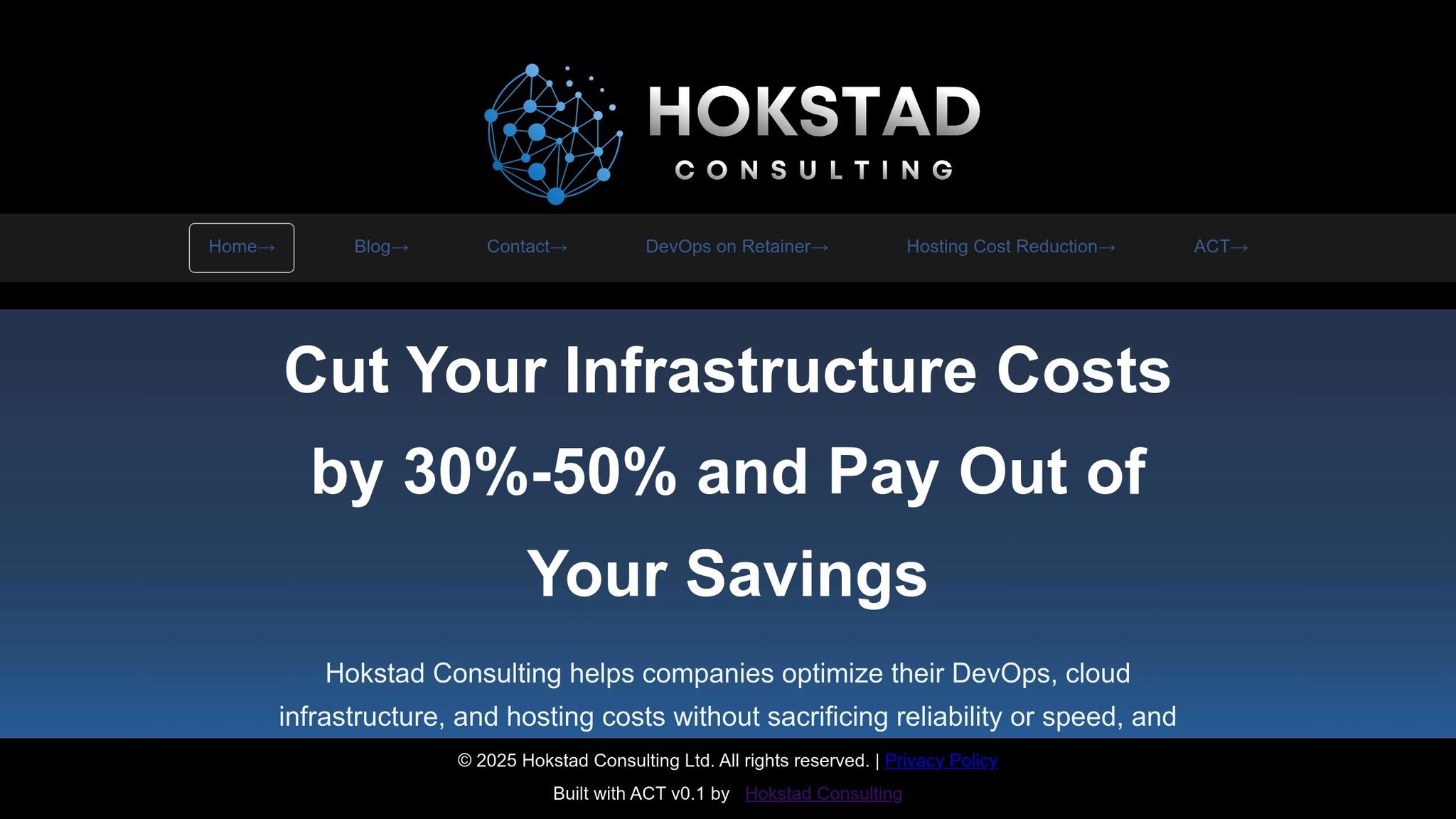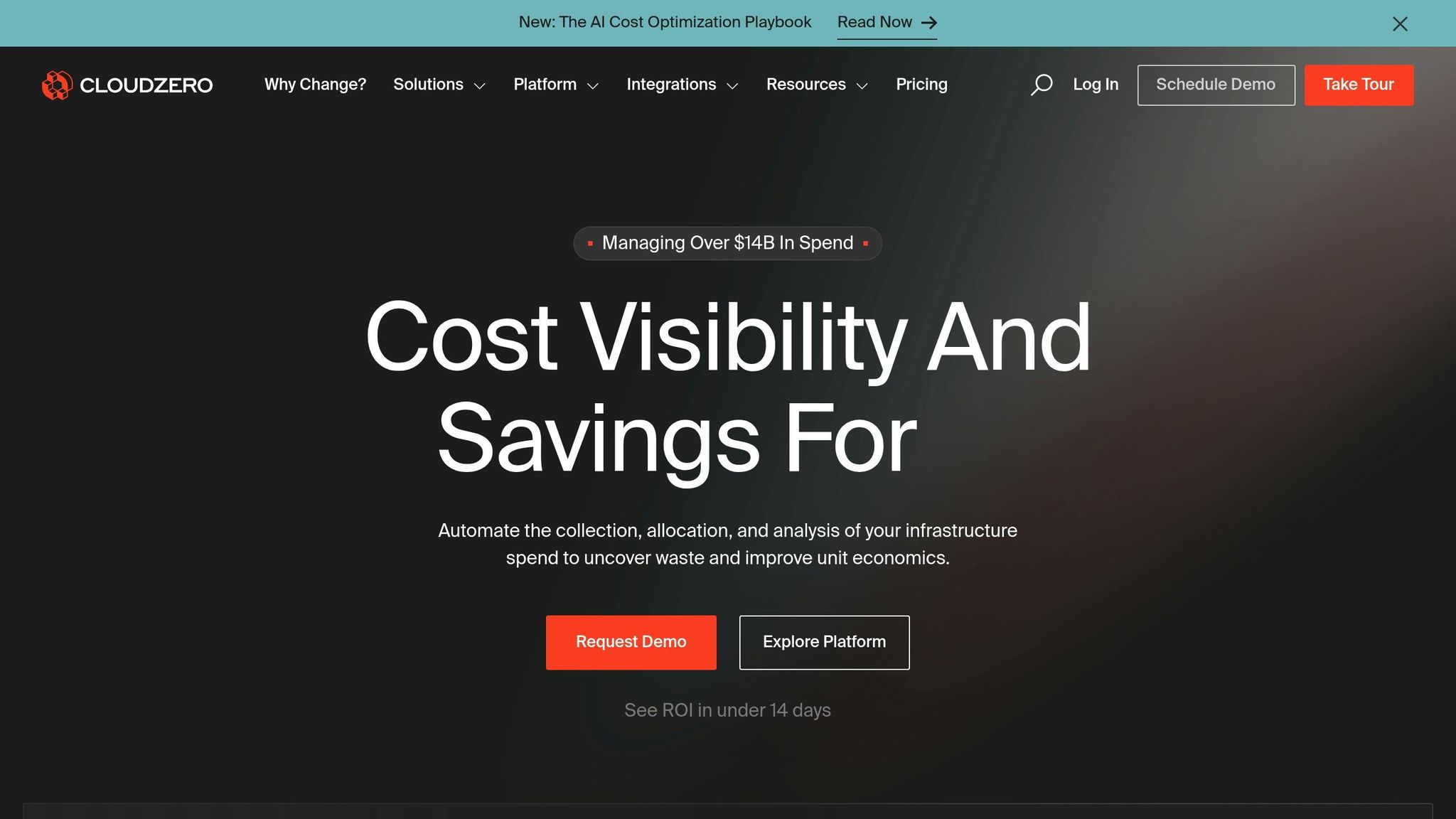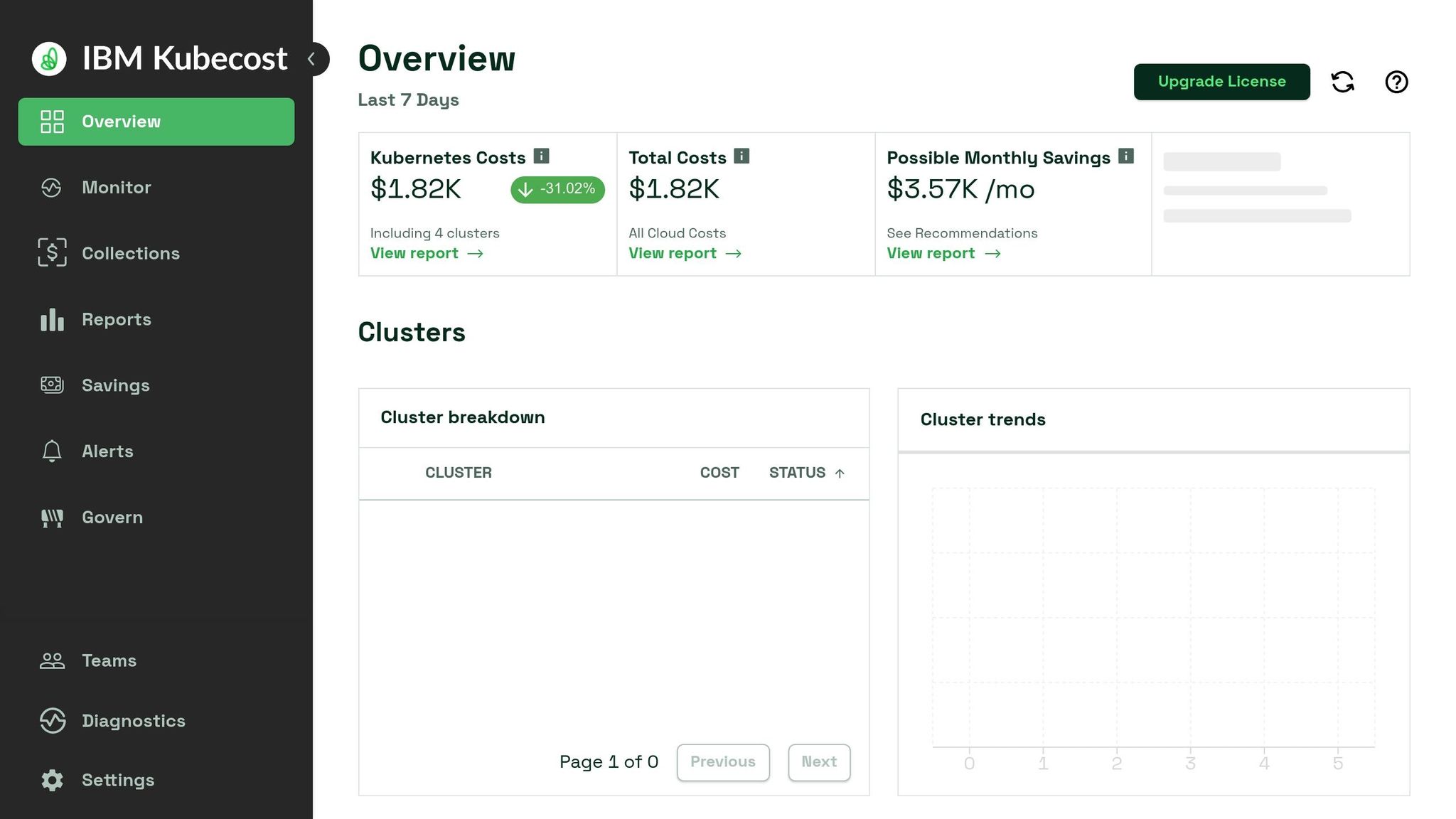Cloud spending in the UK is growing fast, with many businesses struggling to manage costs effectively in complex multi-cloud setups. The main challenges include fragmented visibility, oversized resources, and delayed cost tracking. Third-party tools like CloudZero, Datadog, and Kubecost are helping businesses reduce cloud expenses by up to 40% by offering features such as real-time monitoring, cost allocation, and forecasting.
Key Takeaways:
- CloudZero links costs to business metrics, ideal for multi-cloud environments.
- Datadog integrates cost tracking with performance monitoring, suited for existing Datadog users.
- Kubecost focuses on Kubernetes cost transparency, perfect for container-heavy setups.
These tools provide GBP-based reporting, compliance with UK regulations, and actionable insights to optimise cloud spending. For better results, expert guidance, like that from Hokstad Consulting, can amplify savings and performance improvements.
Top 10 Cloud Cost Management Tools in 2023
Key Features of Cloud Cost Management Tools
Businesses in the UK need tools that can streamline multi-cloud spending into a cohesive financial plan.
Multi-Cloud Support and Integration
The best tools bring together data from major providers - like AWS, Azure, Google Cloud, and private infrastructures - into a single, unified dashboard. This eliminates the hassle of managing multiple billing systems.
For instance, tools such as Flexera and Holori provide provider-agnostic tagging and automated infrastructure mapping, ensuring consistent tracking. A UK-based financial services company using Holori reported an 18% reduction in cloud costs within the first year, alongside improved cost allocation and compliance with UK regulations[2].
Integration with existing DevOps workflows is another critical feature. Effective tools embed cost management directly into development pipelines, allowing automated provisioning and scaling decisions that consider both performance needs and budget constraints. This makes cost optimisation a core part of day-to-day operations rather than an afterthought.
Beyond dashboards, seamless integration also means real-time cost tracking, which is essential for keeping expenses under control.
Real-Time Monitoring and Cost Allocation
Traditional cloud billing often delays awareness of spending until monthly invoices arrive, leaving businesses vulnerable to unexpected costs. Real-time monitoring solves this by offering immediate insights into cloud expenditure, enabling quick responses to sudden cost spikes.
Datadog, for example, combines full-stack observability with detailed resource-level tracking and cost data. Similarly, CloudZero provides granular visibility by allocating costs based on business metrics, making it easier to justify spending decisions.
Automated anomaly detection is another key feature. Tools like Anodot and Finout use advanced analytics to flag unusual spending patterns before they spiral out of control. These tools can catch issues like misconfigured auto-scaling policies or runaway development environments. UK companies leveraging these real-time monitoring capabilities have seen cloud costs drop by as much as 34%, thanks to resource rightsizing and improved operational efficiency[6].
Real-time monitoring naturally complements forecasting, helping businesses maintain better control over their cloud budgets.
Forecasting and Compliance
Advanced forecasting capabilities set sophisticated cloud cost management tools apart from basic billing dashboards. These tools analyse historical usage, seasonal trends, and planned changes to predict future expenses. For UK businesses, compliance features are equally important, offering tailored reporting, audit trails, and integration with financial systems to meet GDPR and HMRC requirements.
Top tools provide customisable reports designed for UK standards, including GBP currency, DD/MM/YYYY date formats, and metric units. They also ensure audit trails are GDPR-compliant and integrate seamlessly with HMRC regulations. Automated compliance within CI/CD pipelines can significantly reduce audit times and improve deployment efficiency, which is especially valuable in highly regulated sectors like financial services and healthcare.
Hokstad Consulting's Approach to Cloud Cost Optimisation

Third-party tools might be a starting point, but it's expert implementation that turns cost tracking into tangible savings.
Cloud Cost Management Services
Hokstad Consulting doesn’t stop at monitoring; they dig deeper by conducting thorough audits to identify inefficiencies that automated tools often miss. These audits can uncover surprising expenses. For instance, one UK SaaS company discovered it was spending £120,000 a year on unnecessary resources. By applying strategies like rightsizing, optimising reserved instances, and implementing automated scaling policies, Hokstad Consulting helped eliminate these costs entirely[5].
Another key aspect of their approach is DevOps transformation. They integrate financial awareness into development workflows, ensuring cost considerations are baked into every deployment. This proactive approach helps avoid costly errors before they happen.
The outcomes are impressive. Clients have experienced deployment times dropping from 6 hours to just 20 minutes while achieving a 95% reduction in infrastructure-related downtime[5]. These results are largely due to custom automation solutions that improve both performance and cost efficiency.
Hokstad also leverages AI-driven optimisation, using machine learning to analyse usage patterns, predict future needs, and automatically adjust resources. This creates self-optimising cloud environments that catch cost anomalies before they show up on your bill.
Their strategic cloud migration planning ensures smooth transitions with zero downtime, while also uncovering opportunities to improve architecture. These improvements often lead to long-term savings that extend far beyond the initial migration.
This hands-on approach sets the stage for bespoke solutions tailored to the specific needs of UK organisations, addressing regulatory and operational challenges head-on.
Tailored Solutions for UK Businesses
Hokstad Consulting goes a step further by customising their services to align with the unique demands of UK businesses.
Generic approaches to cloud cost management often fall short because they overlook the regulatory, financial, and operational specifics of British organisations. Hokstad bridges this gap by tailoring their strategies to meet these distinct requirements.
Their customisation extends to industry-specific needs. For financial services, they implement enhanced security and compliance measures. Retail businesses benefit from scalability solutions designed to handle seasonal demand surges, while healthcare providers receive specialised data protection strategies that balance security with cost efficiency.
Cost reduction often comes with a bonus: improved performance. For example, an e-commerce client saw a 50% boost in performance while cutting costs by 30% through targeted optimisation[5]. These outcomes stem from aligning resources with actual usage rather than over-provisioning for potential peak loads.
Hokstad’s pricing model reflects their confidence in delivering results. They typically reduce cloud spending by 30-50%, with their fees often capped as a percentage of the savings achieved[5][7]. This no savings, no fee
structure ties their success directly to your cost reductions.
Their support doesn’t end once initial savings are realised. Hokstad provides ongoing reviews, updated strategies, and integration of new tools to ensure cost efficiency keeps pace with your evolving business needs. This continuous improvement approach helps prevent the gradual cost increases that can occur when optimisation is treated as a one-off project.
Additionally, custom automation solutions can speed up deployments by up to 10×, freeing developers to focus on innovation rather than infrastructure management[5]. This increased productivity often delivers value far beyond the immediate cost savings, enabling faster time-to-market and strengthening competitive positioning.
Need help optimizing your cloud costs?
Get expert advice on how to reduce your cloud expenses without sacrificing performance.
Third-Party Cloud Cost Analysis Tools
When it comes to managing cloud spending, relying solely on the dashboards provided by cloud providers often isn’t enough. Several third-party platforms offer advanced analytics, automation, and reporting features that help businesses gain deeper insights and take concrete steps to optimise their cloud costs.
CloudZero

CloudZero takes a unique, engineering-focused approach by connecting cloud costs to specific business metrics. For UK companies managing multi-cloud environments, this platform is particularly advantageous as it consolidates data from various cloud providers into one place.
One of its standout features is automated cost categorisation, which reduces the time spent on manual tracking and provides detailed visibility into spending. It also includes anomaly detection tailored for engineering teams, flagging unexpected spending patterns that might arise during development cycles. However, smaller teams might find the integration process and the need for dedicated FinOps support a bit demanding.
A fintech company in the UK used CloudZero to track cloud costs by product feature, address unexpected spikes, and cut monthly expenses by 15% through targeted adjustments[8].
Datadog Cloud Cost Management
If your organisation already uses Datadog for monitoring, its cloud cost management module could be a natural extension. Datadog combines cost analysis with observability, offering real-time cost tracking and resource allocation by team, product, or service. Its unified dashboards display both cost and performance metrics side by side, helping UK businesses understand how resource usage directly impacts spending.
The platform supports multi-cloud environments and displays costs in pounds sterling, simplifying financial reporting for local organisations. For instance, a UK retailer used Datadog to link cloud costs with application performance, optimise resource allocation, and eliminate over-provisioning, ultimately boosting cost efficiency[4]. However, this tool works best as part of Datadog's broader monitoring suite, and its standalone cost management features may feel limited.
Kubecost

For companies heavily invested in Kubernetes, Kubecost provides unparalleled visibility into container-related expenses. It breaks down costs by clusters, nodes, pods, and namespaces, linking internal Kubernetes costs with external cloud services to offer a comprehensive view of total spending on containerised applications.
Kubecost also supports real-time cost tracking and allows businesses to allocate expenses across teams and projects, ensuring accountability. Its open-source foundation is another plus, as organisations can start with a free version and upgrade to enterprise features as their needs grow. A UK healthcare provider, for example, used Kubecost to gain better transparency and accountability across its development teams[2]. That said, Kubecost’s focus on Kubernetes means it’s less suited for organisations without significant container deployments.
| Tool | Best For | Key Strength | Main Limitation |
|---|---|---|---|
| CloudZero | Engineering teams needing business-aligned cost insights | Automatic cost allocation without manual tagging | Requires integration effort and training |
| Datadog | Organisations using Datadog for monitoring | Unified cost and performance visibility | Most effective within the Datadog ecosystem |
| Kubecost | Kubernetes-heavy environments | Granular container cost transparency | Limited to containerised workloads |
These tools, when used alongside strategies like rightsizing, FinOps practices, and AI-driven autoscaling, can help businesses reduce cloud waste by up to 30% and achieve savings of up to 40% on their cloud bills[1][9]. The key is choosing a platform that aligns with your existing setup, supports financial reporting in pounds sterling, and adheres to local data protection regulations.
Comparing Cloud Cost Tools
Choosing the right cloud cost analysis tool is no small task. It demands a thorough look at how each platform matches your organisation’s needs, existing setup, and budget. The three tools discussed here - CloudZero, Datadog Cloud Cost Management, and Kubecost - each bring distinct advantages to the table, catering to different technical environments. Let’s break down their key differences and strengths.
All three tools support multi-cloud data consolidation, making them versatile options. CloudZero integrates seamlessly across AWS, Azure, Google Cloud, and Kubernetes, even pulling billing data from BigQuery for a complete cost picture [10]. Datadog Cloud Cost Management works well with major cloud providers and pairs perfectly with Datadog’s observability platform, offering unified monitoring and cost insights [3][4]. Kubecost, on the other hand, focuses heavily on Kubernetes environments but also supports deployments on AWS, Azure, Google Cloud, and on-premises clusters, making it a strong choice for organisations with substantial container workloads [10].
Pricing Models
The pricing structures for these tools reflect their unique approaches. CloudZero and Datadog typically use tiered or usage-based pricing, with options for GBP billing [3]. Kubecost offers a flexible model, including an open-source version and paid SaaS plans based on the number of clusters or nodes being managed [10]. All platforms ensure their pricing models are compatible with GBP and comply with UK regulations.
Real-Time Monitoring
Real-time monitoring capabilities are another area where these tools differ. CloudZero shines with real-time anomaly detection and precise cost attribution, tying spending directly to business outcomes and sending automated alerts [10][8]. Datadog combines real-time monitoring with cost analysis, offering immediate insights into both performance and spending, though some features may require additional modules [3][4]. Kubecost provides detailed cost tracking for Kubernetes environments, but its narrower focus may limit its appeal for non-Kubernetes workloads [10].
| Feature | CloudZero | Datadog Cloud Cost Management | Kubecost |
|---|---|---|---|
| Multi-cloud Support | AWS, Azure, GCP, Kubernetes | Major cloud providers, strong in Datadog ecosystem | Kubernetes-focused across all major clouds |
| Pricing Model | Usage-based, custom quotes | Tiered subscription models | Free (open-source) and paid enterprise models |
| Real-time Monitoring | Precise cost attribution and anomaly detection | Unified cost and performance insights | Detailed tracking of container costs |
| Best Suited For | Organisations needing business-aligned insights | Organisations using Datadog monitoring | Kubernetes-heavy environments |
| UK Currency Support | GBP reporting available | GBP billing with VAT compliance | Enterprise support with GBP reporting |
User Experience and Forecasting
When it comes to usability, Datadog stands out with its user-friendly dashboards and customisable reports, making it accessible for both technical and non-technical users [3][4]. CloudZero offers highly detailed, business-aligned cost mapping, along with automated alerts and customisable analytics [10][8]. Kubecost, while powerful for real-time Kubernetes cost tracking, has a more technical interface that’s best suited for DevOps and engineering teams [10].
Forecasting and compliance tools are also worth noting. Both CloudZero and Datadog support future cost predictions, budgeting workflows, and custom alerts [3][4]. Kubecost provides cost trend analysis and budgeting for Kubernetes resources, though broader forecasting may require additional integrations [10]. All three platforms can generate compliance-ready reports that align with UK regulatory standards.
Security and Compliance
Security and compliance are critical for UK businesses, and all three tools deliver enterprise-grade features. These include data encryption, role-based access controls, and compliance with GDPR and UK data protection laws. Each tool also provides audit logs and compliance-ready reporting. To ensure local compliance, organisations should review data residency options and contractual terms [3][10].
Which Tool Fits Your Needs?
The best choice depends on your organisation’s priorities. If you’re already using Datadog’s monitoring ecosystem, its cloud cost management module offers natural synergy. For businesses managing complex multi-cloud environments, CloudZero provides detailed, business-aligned insights. Meanwhile, companies with extensive Kubernetes deployments will benefit most from Kubecost’s specialised features.
To help UK businesses optimise their cloud spending, Hokstad Consulting offers expert guidance. Their tailored services include tool selection, integration support, and ongoing cost management, ensuring that these platforms deliver maximum value while meeting local requirements and business goals.
Conclusion
For UK businesses navigating the complexities of multi-cloud environments, third-party cloud cost analysis tools have become indispensable. These tools go beyond the capabilities of native options, offering real-time insights and cost management by consolidating data from AWS, Azure, Google Cloud, and Kubernetes into streamlined dashboards [1][2]. This unified approach not only simplifies oversight but also sets the stage for actionable strategies.
The impact on cost reduction is clear. As highlighted earlier, platforms like CloudZero help businesses identify underutilised resources, while Datadog’s real-time monitoring detects anomalies swiftly. Kubecost, on the other hand, provides precise cost allocation for Kubernetes, enabling more efficient resource use [1][2][4].
But tools alone often fall short without expert guidance. This is where Hokstad Consulting steps in, offering tailored solutions to ensure these platforms deliver maximum value. For example, a UK-based SaaS company saved £120,000 annually by working with Hokstad to implement targeted strategies like resource rightsizing and automation. Similarly, a London e-commerce business saw a 50% boost in performance while cutting cloud costs by 30% after Hokstad revamped their cloud infrastructure and automated deployment pipelines [5].
Hokstad’s performance-based fee model makes their services low-risk and results-focused. Clients typically achieve 30–50% reductions in cloud infrastructure costs while maintaining or even improving performance and reliability [5][11][7]. Their comprehensive approach includes audits, strategy development, targeted adjustments, and advanced automation, all designed to deliver measurable savings with minimal disruption.
Combining advanced tools with expert consulting creates a sustainable framework for cloud cost optimisation. This approach ensures ongoing monitoring, proactive adjustments, and strategic planning, allowing businesses to maintain cost savings even as their needs evolve. For organisations looking to take control of their cloud expenditures, the first step is a thorough assessment of current usage, clear goal-setting, and collaboration with specialists who understand both the tools and the unique challenges faced by UK businesses. With the right implementation and continuous optimisation, companies can achieve significant savings, enhanced performance, and greater operational resilience.
FAQs
How can third-party tools for cloud cost analysis fit into existing DevOps workflows?
Third-party cloud cost analysis tools are built to fit right into your DevOps processes, delivering valuable insights straight into your current workflows. They work by integrating with cloud platforms and CI/CD pipelines, allowing you to monitor and manage resource usage as it happens.
These tools can pinpoint where you're overspending, offer suggestions for cutting costs, and even automate reporting. This means your team can make smarter decisions without interrupting their usual operations. By tying cost insights directly to DevOps practices, businesses can keep their infrastructure running efficiently and economically, all while maintaining seamless deployment cycles.
How does real-time monitoring and cost allocation help with managing cloud costs?
Real-time monitoring and cost allocation give businesses instant visibility into their cloud spending, helping them tackle inefficiencies as they happen. With real-time tracking, you can quickly identify unexpected cost surges and act swiftly to avoid overspending.
Cost allocation goes a step further by assigning expenses to the right teams, projects, or departments. This not only promotes accountability but also supports more effective budget management. When combined, these tools help streamline cloud usage, cut down on waste, and strengthen overall cost control.
How does Hokstad Consulting help UK businesses maximise the value of cloud cost analysis tools?
Hokstad Consulting supports businesses across the UK in maximising the value of cloud cost analysis tools by concentrating on cost optimisation, boosting efficiency, and delivering customised solutions. Their approach often leads to significant savings - typically cutting cloud costs by 30–50% - through techniques like right-sizing resources, automating workflows, and using smarter resource allocation strategies.
Their expertise covers areas such as DevOps transformation, cloud cost engineering, and strategic cloud migration. This ensures businesses not only reduce expenses but also enhance deployment speed and scalability. By offering tailored solutions, they cater to the specific demands of public, private, hybrid, and managed hosting environments, helping organisations streamline their cloud operations and achieve greater efficiency.
